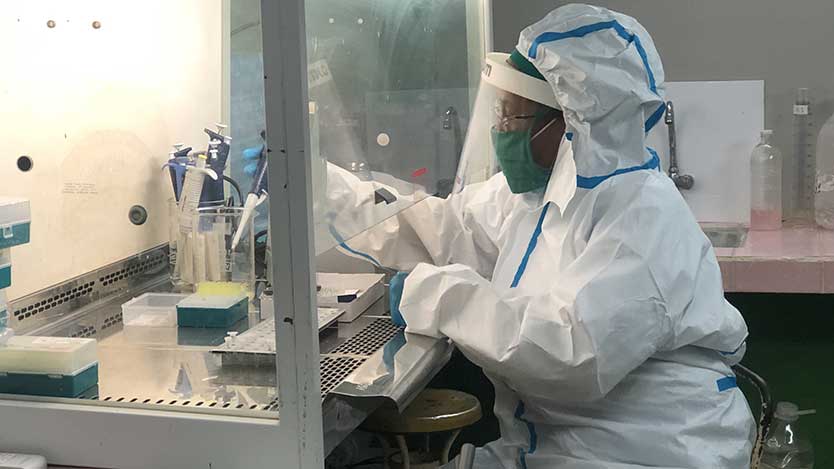
On Saturday, February 5, Ciego de Ávila citizens learned that a group of advisers and experts from the Ministry of Public Health "accompany local specialists in epidemiological assistance and the clinical management of cases”, because here and on La Isla de la Juventud “the highest number of cases and deaths are being reported” at the meeting of the Temporary Group of the Government for the prevention and control of the new coronavirus.
About both indicators, we had published in this newspaper, although we did not have the "national" dimension of the phenomenon. Since daily analyzes are not done it is more difficult to make comparisons. However, the numbers are there and, indeed, Ciego de Ávila continues to drag epidemiological chains that have us today on a statistic table of more than 100 daily cases.
Similarly, with 19 deaths so far this year (just 37 days; one person dies every two days, on average), the alarms go off again, because not everything can and should be explained with the age of the patients and the comorbidities. From late arrival to the health system (when symptoms worsen), the protocol that requires showing symptoms to take an antigen or PCR sample, to the hospital management of cases, are variables that influence the evolution of patients, whether they have the age they are.
Why do not we get out of the COVID-19 "hit parade" in Cuba? More than one reader of Invasor wonders. Are Ciego de Ávila numbers more worrying because they are high or those of the rest because they are low, in the context of a very contagious variant that does not obey regionalisms? Has the out-of-control contagion been limited to just a couple of provinces or do the numbers not say it all?
In my humble opinion—and in the absence of an expert or authorized voice—I think there is a bit of everything and the answers could lie in the number of determinations made each day and in positivity. The most visible data is that of the country as a whole. At the close of February 6, 14,703 were analyzed, almost 8,000 fewer than on December 31, 2021, and about 3,000 less than a year ago. Dr. Durán also confirmed this Monday in his usual weekly appearance: the tendency to reduce the number of determinations is not only Cuban, but also international.
For Ciego de Ávila, with 509 PCRs carried out at the end of Sunday, the volume of samples sent to the laboratory has decreased four times if we compare it with July 2021. Obviously, the health circumstance is not the same, but the effect on the accumulated yes noticeable. Especially if we take into consideration that, after Havana and Matanzas, it is here where most samples are taken, in general.
Therefore, if the incidence of cases depends on the positives diagnosed and our territory processes higher figures than the rest, the chances of finding patients grow. However, according to the graphs presented by the National Director of Epidemiology of the Ministry of Public Health, in the week that ended last Saturday, Ciego de Ávila had a positivity lower than that of eight provinces (although it remained in the group of Muy High Positivity, with 10.5 percent, higher than the national figure did).
It does not help much, by the way, the fact that most of those diagnosed are under the home admission regime. As of the close of February 6, of 878 active cases, 77 percent were at home. Who could ensure that prevention measures are being followed?
Omicron advances and the most irrefutable evidence could be this: a Sunday! the investigation raised 336 suspected cases (with symptoms), of which 38 are considered risk population (due to age or comorbidities), according to the report of the Provincial Directorate of Health shared to the press by Dr. José Ramón Artigas Serpa, specialist in Second Degree in Epidemiology.
The expert's calculations predict that the province will continue this week with daily averages of 150-160 cases. Likewise, it points out that so far this year the majority of patients are female, symptomatic and in the age group of 40-59 years.
One piece of information that we always review, because it is important, is the time elapsed between the onset of symptoms and diagnosis/admission. According to Artigas, in 2021 only 18.2 percent were admitted within 48 hours of the first symptoms, while those that took more than four days represented 56.4 percent (and of them 32.7 percent with more than six days).
The bad news is that, in the last 15 days, although the proportions have decreased, the group of people who take time to isolate themselves is still very high. “This continues to favor community transmission if quality investigations are not carried out and all contacts and suspects are entered in a timely manner,” says the epidemiologist.
Time between symptoms and diagnosis was no better in 2021. 77.4 percent of patients took four or more days to get a result, and of those, 46.5 took six. Comparing the total with what happened in the last fortnight, there could be the incentive that the wait is reduced, but not so much as to erase the dangers involved. The expert insists that without timely diagnosis, the start of treatment is delayed in positive cases and favors the probability of complications and death.
